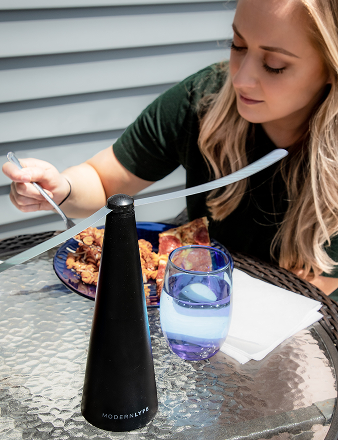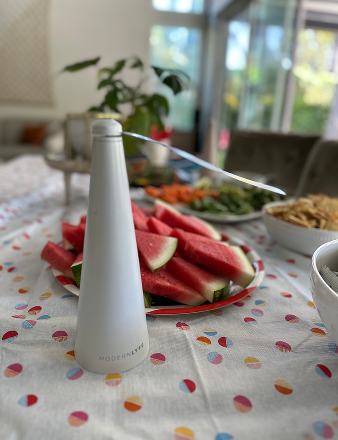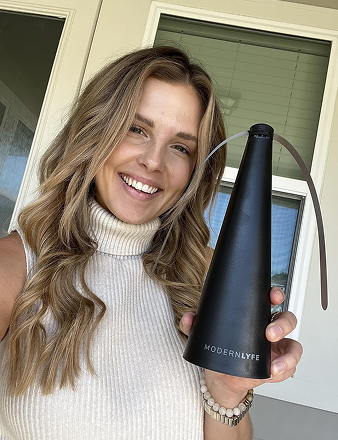You’ve seen them mounted above the entrance to a restaurant or shop, but you might not have known what they are. An over door fly fan, also known as an air curtain, is a simple yet powerful device. It creates an invisible barrier of air that stops flying insects before they can get inside—no chemicals needed.
Think of it as a clean, modern alternative to sticky fly traps or harsh chemical sprays. For any home or business that wants to keep its doors open without inviting in every pest in the neighborhood, this is the solution.
The Modern Way to Stop Flying Pests
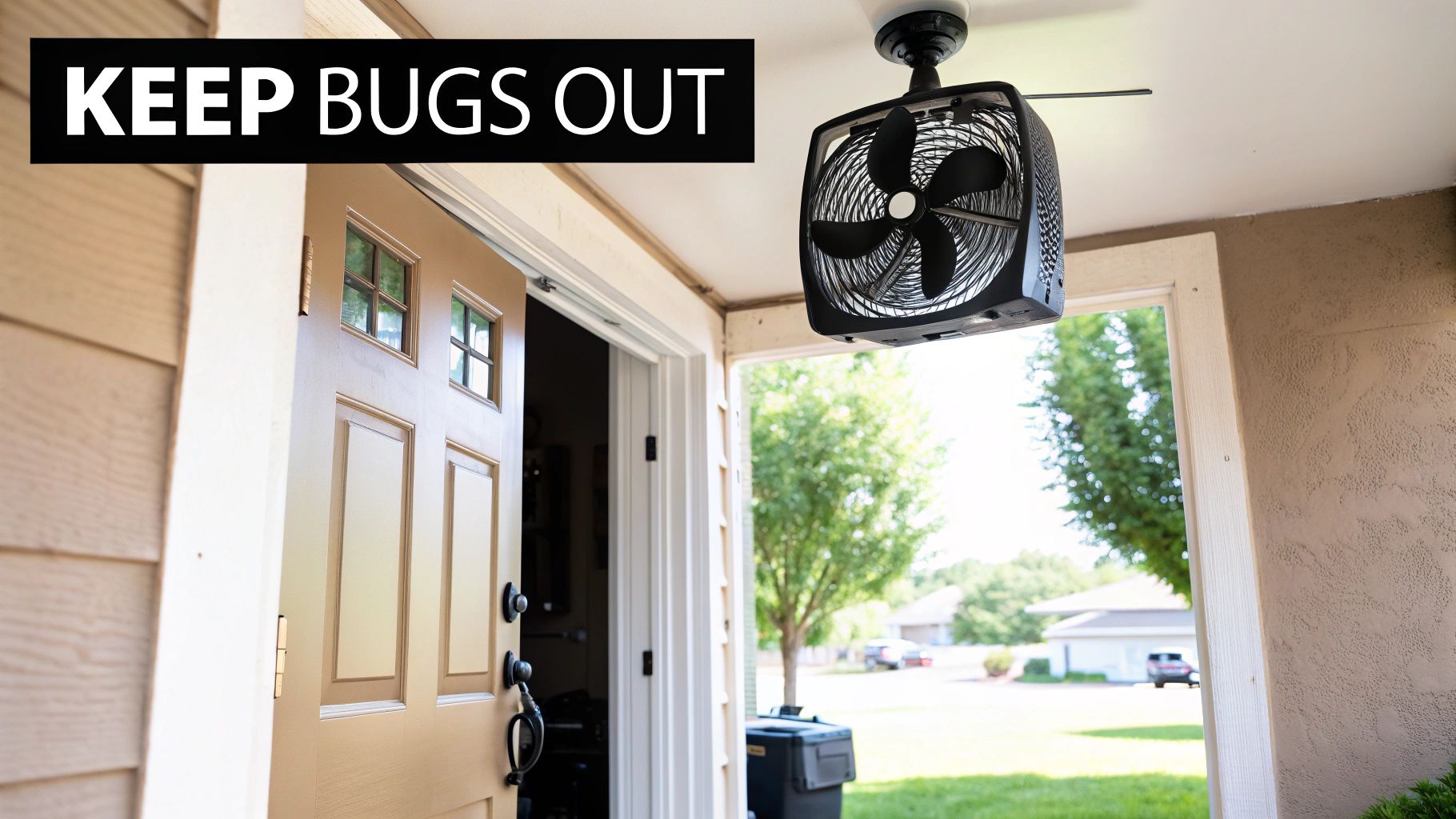
Let's be direct: dealing with flies, gnats, and mosquitoes is a headache. Traditional methods often fall short. Bug zappers are loud and messy, sprays fill your space with chemicals, and sticky fly strips are just gross. An over door fly fan offers a smarter, more elegant answer.
Imagine an invisible waterfall of air flowing down from the top of your doorway. That's the basic idea. The fan generates a powerful, continuous stream of air directed downwards, creating a curtain that small insects can't fly through. They get pushed back, unable to cross the threshold. It’s that simple.
More Than Just Pest Control
While keeping bugs out is their main job, the benefits don't stop there. These units are also great for maintaining your indoor climate. The air barrier helps keep your cool, conditioned air from escaping in the summer. In winter, it prevents warm air from flowing out. The result? Real savings on your energy bills.
This dual-purpose design makes them a valuable addition to any space. Here’s what they bring to the table:
- Improved Hygiene: Keeping flies out is critical for any place that handles food. For restaurants, cafes, and commercial kitchens, this drastically cuts the risk of contamination.
- Enhanced Comfort: Nobody enjoys batting away insects. An air curtain creates a more pleasant environment for customers and staff, free from both pests and drafts.
- Unobstructed Access: Unlike screen doors, an air curtain keeps the entrance completely open. People can walk in and out freely, improving accessibility and traffic flow.
An over door fly fan doesn't just repel pests; it creates a cleaner, more energy-efficient, and comfortable indoor atmosphere. It’s an investment in both sanitation and smooth operations.
A Growing Trend in Air Quality
The technology behind the over door fly fan is part of a larger shift toward better indoor air management. People are more aware than ever of how air circulation affects health and comfort.
It's no surprise the global ventilation fan market was valued at USD 3.57 billion and continues to grow. You can dive deeper into the ventilation market trends from Grand View Research. This growth shows that controlling airflow is now a priority. By installing an over door fly fan, you're not just solving a pest problem—you're adopting proven technology that meets modern standards for cleanliness and efficiency.
How Air Curtains Create an Invisible Shield
An over door fly fan might look simple, but it relies on smart physics. It doesn't just blow air randomly. Instead, it engineers a powerful, high-speed stream of air that forms an invisible barrier in your doorway. This targeted airflow is what stops flying insects from getting inside.
The secret is laminar flow. Imagine a smooth, glass-like waterfall where all the water flows straight down without splashing. An air curtain does the same thing with air, creating a uniform, non-turbulent sheet that flows directly from the unit to the floor.
This steady column of air moves from the high-pressure environment inside the fan to the lower-pressure area of your open door, creating an invisible wall. For a tiny insect like a fly, trying to fly through it is like a person trying to walk through a hurricane. The force is too strong, pushing them back outside.
Anatomy of an Air Shield
Creating this powerful barrier requires a few key parts working in sync. Each component has a specific job focused on controlling the air to seal off the opening efficiently. This design is what makes an over door fly fan far more effective than just pointing a regular fan at the door.
Here’s what’s inside:
- The Motor: This is the engine. It provides the power to pull in surrounding air and start the process. The motor's strength determines how powerful the air shield will be.
- Blowers (or Impellers): These are the spinning, cylindrical blades. As the motor turns them, they suck air into the unit, compress it, and get it ready to be forced out.
- The Nozzle: This is where the magic happens. The nozzle is a precisely shaped vent that takes the pressurized air and focuses it into that thin, high-velocity curtain.
The goal isn't just to move air, but to shape it into a potent, impenetrable shield. The synergy between the motor, blowers, and nozzle is what separates an air curtain from a simple fan.
This is a great visual breakdown of how airflow speed, pest control, and energy consumption are all connected.
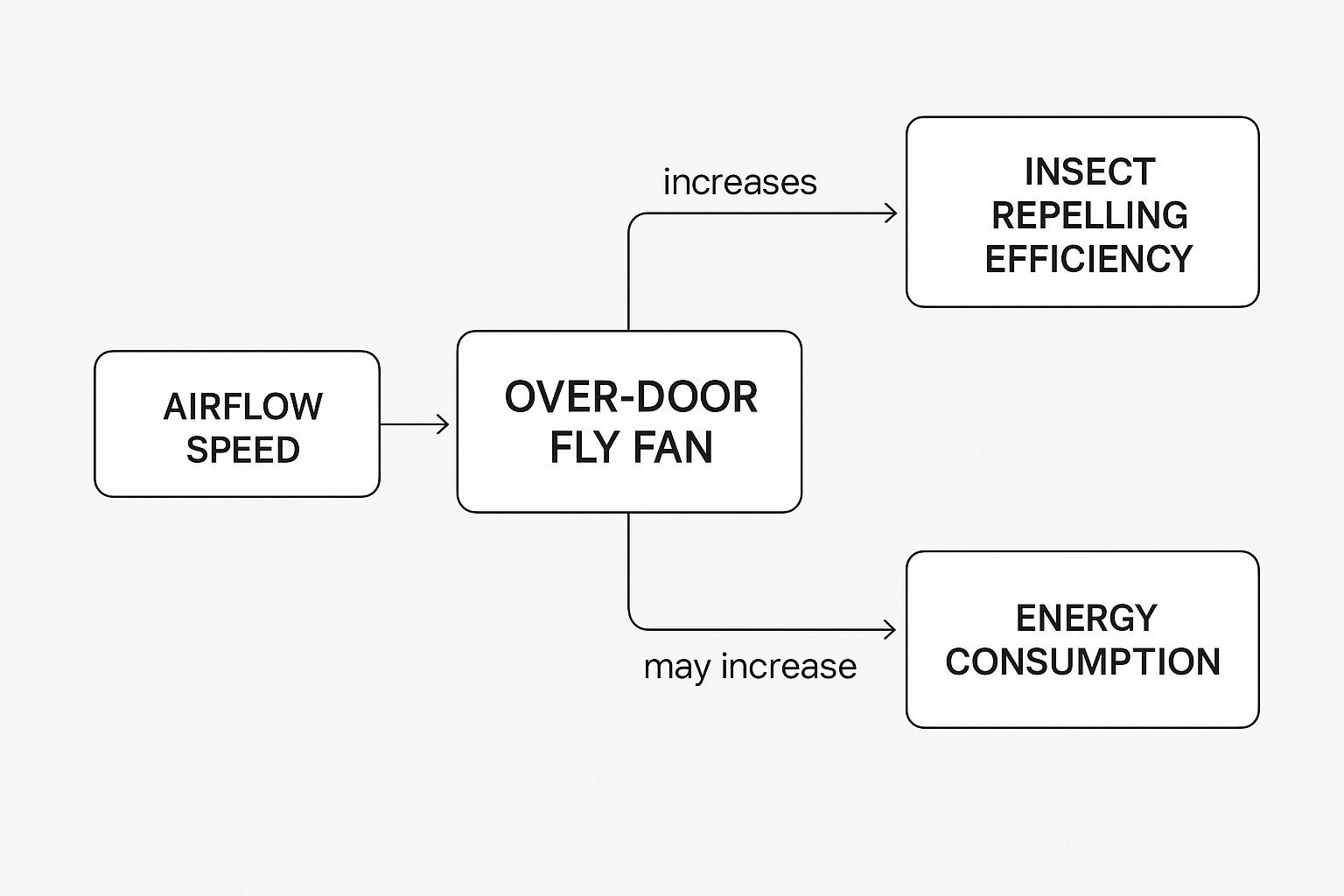
As you can see, hitting the sweet spot between performance and energy efficiency is key to getting the best results without a huge electricity bill.
A Clear Distinction from Standard Fans
It's easy to think an air curtain is just a powerful fan mounted sideways, but they're fundamentally different. A standard fan is designed for circulation. It creates a wide, turbulent airflow to move air around a room and make you feel cooler. Its purpose is to mix the air.
An over door fly fan is built for the opposite: separation. Its entire design is focused on creating a concentrated downward force that cleanly covers the entire doorway. This invisible barrier doesn't just block pests; it also helps keep dust, pollen, and fumes out while preventing your conditioned air from escaping.
If you're exploring all your options for a bug-free space, our detailed guide on different types of door fans to keep bugs out is a great place to continue your research.
Why Every Entryway Needs an Air Curtain
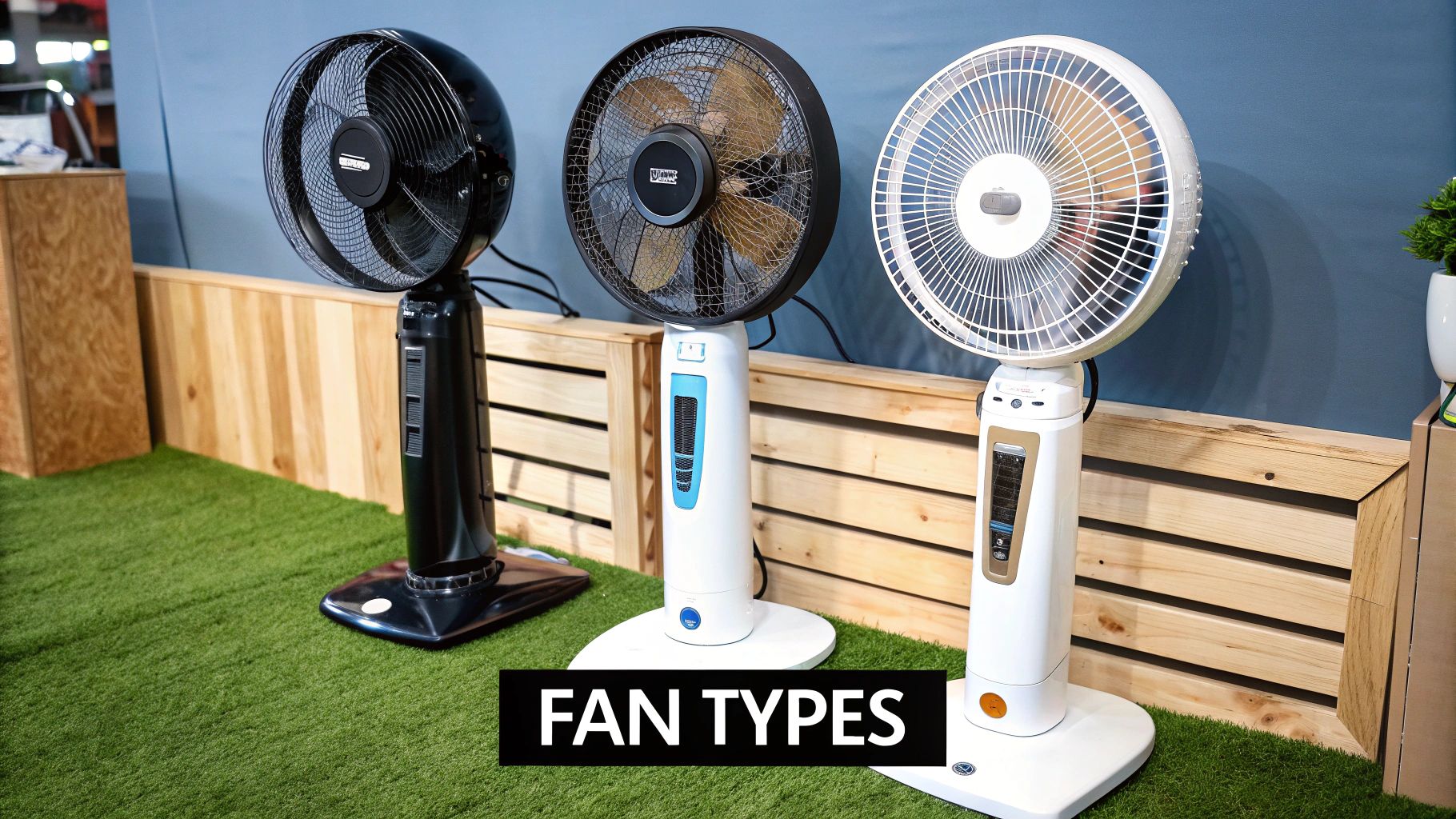
Sure, the main job of an over door fly fan is to stop flying insects. But that's not all it does. These devices are more than a bug zapper alternative; they're a powerful tool for improving the entire feel of an indoor space.
From sanitation and energy savings to pure comfort, the benefits are real for both businesses and homes. An over door fan isn't just a gadget—it's a proactive way to create a cleaner, more welcoming, and cost-effective environment.
A Fortress of Hygiene and Sanitation
In any place where food is prepped, served, or sold, hygiene is non-negotiable. Flies are notorious for carrying germs, and just one can contaminate a clean surface instantly. An over door fly fan is your first line of defense.
By creating a powerful, invisible barrier of air, it physically blocks pests from ever getting inside. This is a game-changer for places like:
- Restaurants and Cafes: It keeps kitchens and dining areas protected, ensuring a safe and pleasant meal for customers.
- Food Processing Facilities: Maintaining sterile conditions is crucial for meeting health codes, and an air curtain helps lock those conditions in.
- Grocery Stores: It keeps produce, meat, and bakery sections free from insects that could spoil food.
Best of all, it's a completely chemical-free solution. You don't have to worry about sprays or traps near sensitive food areas.
Significant Energy Savings
An open door is like a hole in your wallet. In summer, expensive cool air rushes out. In winter, your warm air escapes, making your HVAC system work overtime. The result? Sky-high energy bills.
An over door fly fan acts as a climate separator. It creates an air shield that traps your conditioned air inside while keeping the outside weather out. Some studies show that a well-placed air curtain can cut the energy loss through an open doorway by up to 80%.
By preventing the constant exchange of indoor and outdoor air, the fan essentially pays for itself over time through lower utility bills. It also shrinks your carbon footprint, which is a fantastic bonus.
Boosting Comfort for Everyone
Beyond the practical benefits, one of the biggest wins is the immediate boost in comfort. An open door means drafts, temperature changes, and an invitation for dust, pollen, and fumes to wander inside.
The air curtain solves all of that by stabilizing the indoor atmosphere. No more chilly drafts in the winter or waves of hot air in the summer. For a business, this means you can keep your doors open to welcome customers without making anyone uncomfortable. At home, it means you can enjoy an open entryway without the onslaught of allergens and bugs.
This isn't a niche idea. The global market for household fans, which includes air curtains, was recently valued at around USD 33.63 billion and is expected to climb. If you're curious, you can read the full research about the expanding fan market. It’s clear people are moving toward smarter, more efficient ways to manage their air.
To put it all in perspective, here's a quick breakdown of how these benefits play out.
Over Door Fly Fan Benefits at a Glance
| Benefit Category | Impact on Commercial Spaces | Impact on Residential Homes |
|---|---|---|
| Pest Control | Creates a professional, hygienic image and helps meet health codes. Protects inventory. | Keeps the home free of annoying and unhygienic flies, mosquitoes, and gnats. |
| Energy Efficiency | Significantly reduces heating and cooling costs, especially for high-traffic entrances. | Lowers monthly utility bills by preventing conditioned air from escaping. |
| Comfort & Air Quality | Eliminates drafts for customers and staff. Blocks dust, pollen, and outdoor odors. | Creates a more stable and pleasant indoor temperature. Reduces incoming allergens. |
| Customer Experience | An open, welcoming door without the downsides encourages foot traffic and comfort. | Allows for an "open door" feel without inviting pests or the elements inside. |
Ultimately, whether you're running a busy cafe or just want a more comfortable home, the impact is immediate.
How to Choose the Right Over Door Fly Fan
Picking the right over door fly fan isn’t about grabbing the most powerful one. It’s about finding the perfect fit for your specific doorway. A fan that’s too small leaves gaps for pests to get through. One that’s too big is just noisy and wastes energy.
Let’s walk through what really matters so you can find a solution that works. It all starts with a tape measure.
Matching Fan Size and Power to Your Doorway
The golden rule is simple: your fly fan unit needs to be at least as wide as your doorway, and ideally a little wider. If the air curtain doesn't cover the entire opening, you're leaving an open invitation for insects.
Once you have the width, the next number to know is Cubic Feet per Minute (CFM). Think of CFM as the fan's power—it tells you how much air it can push. Taller doors or windy entryways need a higher CFM to create a strong enough air barrier.
Here’s a quick checklist to get you started:
- Measure Your Door: Get the exact width and height. You want the fan to extend just past the door frame on both sides.
- Check Your Environment: Is the door in a calm corner, or does it face open space with a lot of wind? Windy spots demand a higher CFM.
- Consider Foot Traffic: A busy restaurant entrance needs a much more powerful fan than a residential back door.
Nailing these basics is more than half the battle. If you want to dive deeper into how different fans work, your guide to the modern fly fan is a great resource.
Evaluating Noise Levels and Controls
After you’ve sorted out size and power, think about what it will be like to live or work with the fan every day. The noise level and controls make all the difference.
Noise is measured in decibels (dBA). For a quiet spot like a café or boutique, you'll want a unit with a low dBA rating. For a loud commercial kitchen or a bustling warehouse, a bit more noise is a fine trade-off for better performance.
Choosing the right controls is about convenience and efficiency. You want a system that works seamlessly with how your door is used.
Your control options can be straightforward or advanced:
- Manual Switches: The most basic setup—a simple on/off switch, sometimes with a high/low speed setting. It’s a great, no-fuss option for doors that stay open for long periods.
- Door Sensors: For a smarter, more energy-efficient approach, look for a fan that connects to a door sensor. The unit turns on when the door opens and off when it closes, saving money and reducing wear on the motor.
The market for industrial fans, which includes these powerful air curtains, is massive. It was valued at USD 7.24 billion globally. This shows how many businesses rely on effective air solutions. You can discover more insights about industrial fan market growth from Grand View Research.
Focusing on Energy Efficiency
Finally, don't forget the long-term running costs. An energy-efficient over door fly fan is good for your wallet and the planet. Today’s best models deliver a powerful blast of air without a huge utility bill.
Look for models with variable speed controls, which let you adjust the fan's intensity. Another key feature is an EC (Electronically Commutated) motor, which is far more efficient than older AC motors. By investing in an efficient model upfront, the fan will quickly pay for itself in energy savings.
A Simple Guide to Installation and Maintenance
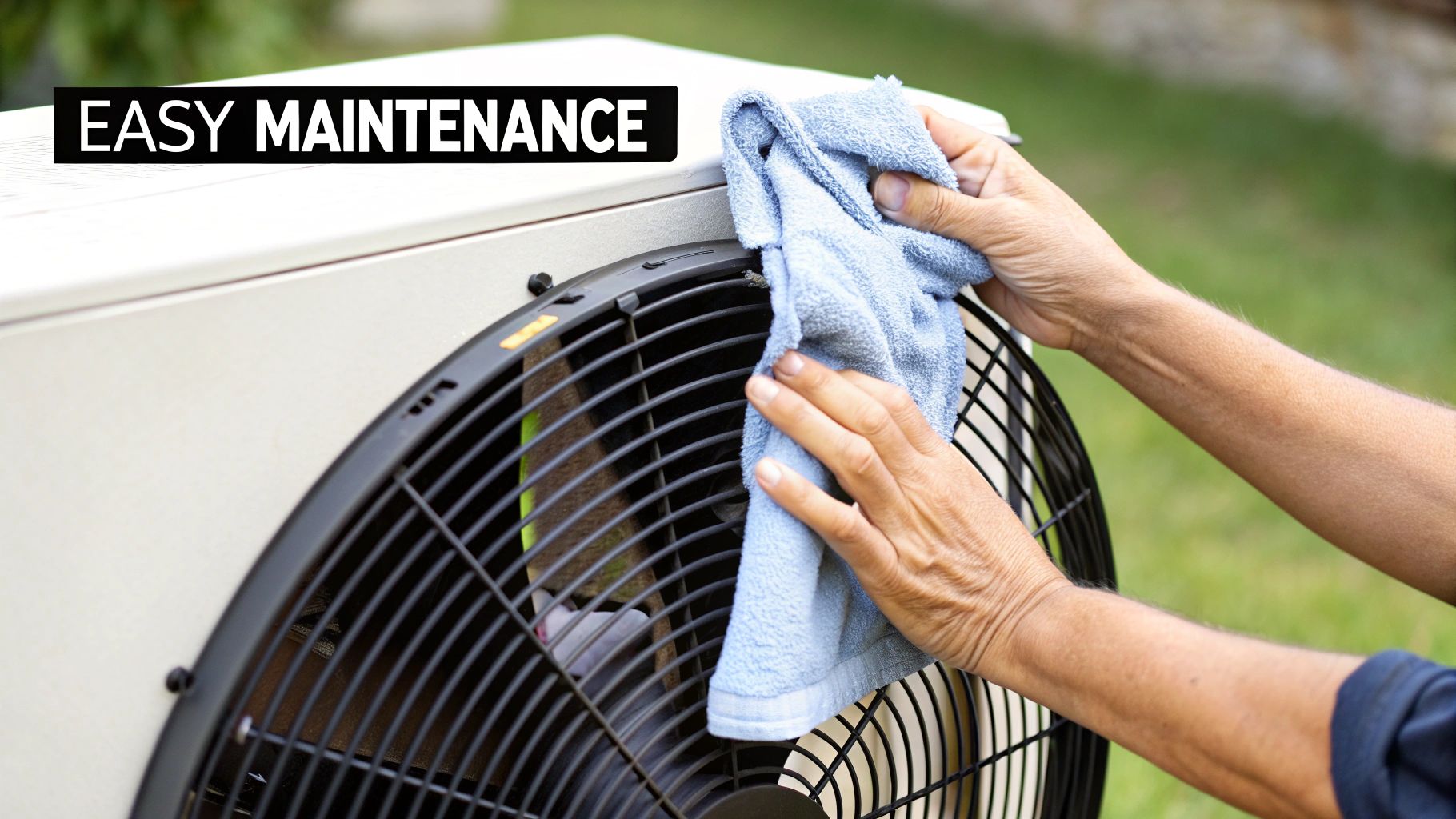
You’ve picked the perfect over door fly fan, and now it's time to get it running. Proper installation is key to unlocking its full potential. Likewise, a little routine maintenance will keep it working for years.
We'll walk you through the essentials. While many people can tackle the basics, remember that safety always comes first, especially with electricity.
Installing Your Over Door Fly Fan
Positioning your fan correctly is everything. If it’s mounted too low, it won’t create an effective air curtain. Too high, and the airflow will lose its power before reaching the floor, leaving a welcome mat for pests.
Your goal is to mount the unit as close to the top of the door frame as possible without blocking the door. This ensures the stream of air covers the entire opening evenly and with enough force.
Here’s a breakdown of the key installation steps:
- Choose the Right Spot: Center the fan directly above the doorway. Fasten it securely to a solid structure, like a wall stud or a reinforced header, to support its weight.
- Check for Clearance: Most models need a few inches of clearance above them to pull in air properly. If it can't breathe, it can't work.
- Secure the Mounting Bracket: Follow the manufacturer's instructions to attach the mounting plate. Use a level to make sure it’s perfectly horizontal; a crooked fan means uneven airflow.
- Connect the Electricals: This is the most important part. Many units are simple plug-and-play models, but some require hardwiring.
When to Call a Professional: If your fan needs to be hardwired into your building's electrical system, this is not a DIY job. Always hire a licensed electrician. Faulty wiring is a serious fire hazard and can ruin your new fan.
Keeping Your Fan in Top Condition
Once your over door fly fan is installed, a simple maintenance routine is all it takes to keep it effective. A fan clogged with dust can't move air efficiently. This weakens the air curtain and puts unnecessary strain on the motor.
A regular check-up only takes a few minutes but makes a world of difference.
Here’s a simple maintenance checklist:
- Clean the Intake Grilles: At least once a month, turn off the power and wipe down the air intake grilles with a soft cloth or brush. This prevents dust buildup.
- Inspect the Housing: Give the fan’s exterior a quick wipe-down. While you’re there, check for any loose screws or rattling parts.
- Listen for Unusual Noises: If you hear any grinding, rattling, or whining sounds, that’s an early warning sign of a motor or blower issue that needs looking into.
Following these simple tips will ensure your over door fly fan operates at its best, keeping your space pest-free for years to come.
Frequently Asked Questions
Thinking about getting an over door fly fan? You probably have some questions. It’s a straightforward way to handle pests, but getting the details right will make you more confident in your choice. Let's cover some of the most common questions.
We'll cover everything from noise and energy use to whether they work in the winter.
Are Over Door Fly Fans Loud?
The simple answer is: it depends on the model. Manufacturers design them for different environments.
Residential models are built to be discreet. Their sound is often no louder than a typical pedestal fan—a gentle hum you'll quickly tune out. You get fly-stopping power without the noise.
Commercial units are all about performance. The ones in restaurant kitchens or industrial spaces are louder because they need raw power for high-traffic doorways. Manufacturers list a decibels (dBA) rating, so you can pick a quiet fan for a customer entrance or a powerful one for the back of the house.
How Much Energy Do These Fans Use?
It's smart to think about your electricity bill. The good news is that modern over door fly fans are designed to be efficient. They use motors that push a lot of air without using a lot of power, so the day-to-day cost is minimal.
The real story is how much energy they save. By creating a wall of air, the fan keeps your indoor climate separate from the outside. That means your air conditioner or heater doesn't have to work overtime, whether you're battling summer heat or a winter chill.
This climate separation can lead to significant reductions in your heating and cooling costs. The energy savings can often offset—and even exceed—the fan's operating cost over time.
By stopping conditioned air from rushing out the door, an over door fly fan basically pays for itself.
Can I Use One for Warmth in the Winter?
Absolutely. While standard models blow unheated air, many brands offer heated versions that work all year long. They act as a bug barrier in the summer and a source of warmth in the winter.
Heated air curtains pull air through an electric heating element before pushing it down. This creates a welcoming curtain of warm air at the door, which accomplishes a few key things:
- Supplements Your Heating: It eases the burden on your main HVAC system by tackling the coldest spot in the building.
- Boosts Comfort: It gets rid of cold drafts, making things more pleasant for customers and staff.
- Stops Heat Loss: The air barrier traps your heated air inside.
For any business or home in a colder climate, a heated model is a brilliant investment for all-in-one pest control and temperature management.
Is an Over Door Fly Fan Effective Against All Flying Insects?
An over door fly fan is extremely effective against most common flying pests. The powerful downward blast of air is too much for small insects like house flies, gnats, mosquitoes, and fruit flies to fly through.
It gets trickier with larger, stronger insects like bees or wasps. Their size and flight power might let them muscle through a weaker air stream. But for the vast majority of annoying bugs, a properly sized over door fly fan is an almost impenetrable shield. This is especially vital for keeping things sanitary around food. For more tips, check out our guide on how to keep flies away from food.
Can I Install an Over Door Fly Fan Myself?
If you're handy with basic tools, you can likely install many smaller residential units yourself. They usually come with a simple mounting bracket and straightforward instructions. If it's a plug-in model, it’s as easy as securing it to the wall and plugging it in.
However, know when to call a pro. If a unit needs to be hardwired directly into your building's electrical system, you must hire a licensed electrician. Messing with wiring is dangerous, and a bad connection can be a serious fire hazard. A professional will make sure it's done safely and up to code.
For a stylish and effective way to protect your personal space from flies, MODERN LYFE offers beautifully designed fly fans that are perfect for home gatherings, outdoor dining, and events.
Explore our collection and find your perfect fly fan at MODERN LYFE


